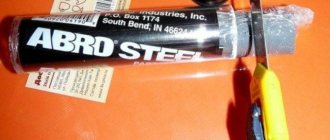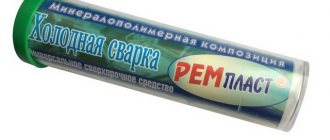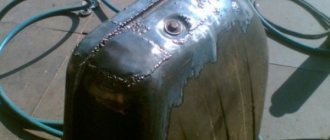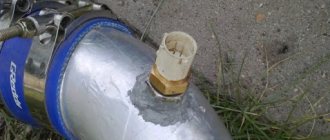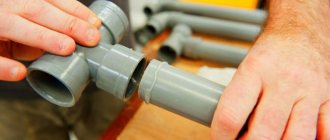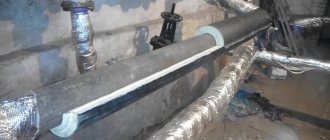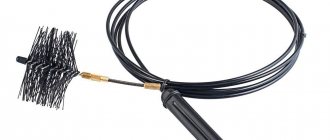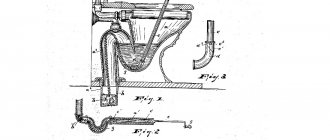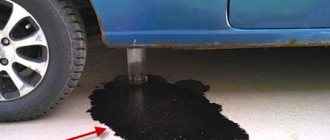Ceramic and metal pipes are losing their popularity; they have been replaced by plastic products, which stand out for their durability and lightness. But a long service life can only be ensured if their installation was carried out correctly and reliable adhesive for PVC pipes was used. More information about which pipe adhesives are best to choose will be discussed below.
Adhesive for PVC pipes
To glue these products together in order to create reliably sealed joints, special glue for plastic pipes is used. “Cold welding” makes it possible to build a water supply as quickly as possible. But the process has its own characteristics.
Advantages of adhesive pipe joints
Plastic pipes can be welded, glued and joined mechanically. The most popular method is welding. But it requires expensive equipment and can only be performed by professionals. Gluing can help achieve the same quality result, sometimes the seams are even stronger.
True, most adhesives for sewer pipes are effective for cold water supply; exposure to high temperatures can damage their integrity.
They have a number of positive properties:
- The risk of leaks is reduced. The seams are completely sealed and can only be negatively affected by exposure to hot temperatures and pressure;
- Easy to use, installation can be done by hand, no additional steps are required;
- It is not difficult to glue plumbing pipes with an adhesive composition, and this saves money on the services of professionals, and you also do not need to buy a welding machine;
- Universal use, one solution can be used to create sewerage and water supply systems.
How cold welding is used in heating systems
Since ancient times, humanity has needed a way to create a strong connection between metal parts that is not subject to oxidation.
The technology of reaction adhesive consists in the plastic transformation of the metal surface, during which the oxide film is destroyed.
This allows the metals to join firmly and not oxidize subsequently. Additional advantages of the product are the speed of setting and the absence of the need for additional heating of the products.
The basis of the composition is epoxy resin. Externally, the product is similar to putty.
The cold welding method allows you to repair radiators, radiators, pipes, and risers. These can be copper, steel, cast iron, tin, aluminum, nickel, lead or polymer pipes or parts.
When carrying out work, you must adhere to the operating rules. The resulting seam will be weaker than one made using electric welding, however, its strength is sufficient to quickly eliminate defects.
Methods for gluing PVC pipelines
There are two main methods of joining materials: hot and cold. The first option involves the use of a soldering machine; this technique helps to obtain high-quality adhesion. Even if the sealing did not work out well, the seam did not come out correctly, the fixation will be reliable, because the temperature is applied to at least 260 degrees. The second method will be discussed below.
READ ALSO: How to Solder Polypropylene Pipes If Water Dripping
Which method is best to use
The choice of method depends on the operating conditions and the purpose for which the pipes are intended. Cold welding can only be used for cold water supply. The choice can also be influenced by budgetary possibilities; cold bonding is cheaper. After all, you can do without the services of professionals; the method is simple.
Advantages of cold welding
The use of adhesives for polyethylene and polyvinyl chloride pipes has its positive qualities that distinguish this method compared to the hot method:
- The structure of the material remains smooth, which further helps to avoid the formation of blockages;
- There will be no leaks, the reliability of the connection is enormous;
- The process takes little time;
- Ease of operation, which saves money.
Priority actions when a leak is detected
If a leak appears on a heating or high-pressure pipe, you must immediately shut off the system using shut-off valves. To solve the problem of how to seal a hole in a plastic pipe, you can use a clamp. Such structures are characterized by very simple use, which consists of putting them on the damaged area and tightening the bolts.
An older method is to use rubber: heating and water pipes are often repaired this way. This involves wrapping a piece of rubber around the damaged area, which can be done using an old car tire.
For clamping, use a clamp, thin wire or strong cord. Ordinary oil paint is also used, which is spread on a fabric pre-wound over the leak (read also: “How to fix a leak in a plastic pipe - options for sealing a leak”). All these methods have only a temporary effect, since the leak will definitely make itself felt later. The best option for repairing a crack in a plastic pipe is to completely replace the problem area, especially since in the case of plastic pipes this is not difficult to do.
READ ALSO: HDPE pipe: what kind of pipe is it, purpose, range and technical characteristics, correspondence between the diameters of HDPE and steel pipes
The nuances of choosing the right type of glue
To choose the right adhesive for plastic pipes for water supply, you need to know a number of criteria:
- The place where the gluing will take place depends on the zones and conditions, which compounds should be purchased. You may need to purchase several different solutions;
- The pressure exerted on the material, manufacturers indicate in the instructions how much pressure the seam can withstand;
- Exerted loads. If the composition is not of very high quality, then displacement may occur under mechanical stress, so you should choose high-quality solutions;
- Temperatures and solutions may only be suitable for certain purposes, so you need to study the information about the purpose of the product on the packaging;
- Pay attention to the components, they may contain toxic substances. If a person is prone to allergies, then he should not carry out the work himself.
READ ALSO: What are Ends for Polyethylene Pipe
Review of the best brands
Adhesives for HDPE pipes and pipes made of other types of plastic are produced by different manufacturers. The most popular of them:
- TANGIT, has a quality certificate, suitable for cold water. Creates a particularly strong grip and is easy to use;
Products from Phoenix and Vinilit companies are also in demand.
Description of composition
The basis of reaction adhesive for metals and plastics is a polymer with high strength indicators - epoxy resin.
This is a two-component product, which necessarily includes a hardener - it is responsible for the ability of the epoxy to thicken.
Sometimes a solid hardener is found; such a material activates its properties when exposed to air and after mixing.
The material has excellent penetration, which allows it to efficiently eliminate the smallest depressions or cracks. The mass is plastic and homogeneous.
To impart additional qualities, sulfur, steel powder, and plasticizers are added to cold welding. The presence of such additives is mandatory in putty for radiators.
Step-by-step instructions for using the composition
Work should be carried out at temperatures from +5 to + 30 degrees, good ventilation should be ensured. The following steps are performed:
- First, the pipeline must be cleaned of all types of contaminants and also degreased;
- They make markings, indicate the places where the coupling will take place, it is better to draw a diagram in advance;
- The pipes are cut to the required sizes;
- You can use a glue gun or a brush to apply glue. The solution should be applied evenly to the surface; there should be no empty areas;
- Having connected the parts, hold them for half a minute so that setting occurs, it is advisable to leave them for 24 hours;
- If excess glue comes out, wipe it off immediately;
- After 24 hours, the fixation is checked to see if there are any leaks left.
Rules for working with adhesives
To cut the material, it is better to use a pipe cutter; it will ensure smooth cutting. It is better to also treat the surface with sandpaper to improve adhesion.
It is recommended to try on the materials first to ensure correct cutting.
Welding Applications
On large defects, the applied glue is covered with a metal patch.
You can fix the leak by sealing the crack with a crushed piece of plastic, or by using fiberglass cloth or threads dipped in epoxy resin, which can then be wrapped with wire or rubber.
The strength of the composition can be increased by adding aluminum or bronze powder to it, which is obtained by grinding any part from the desired material over paper.
The resulting material is used to eliminate severe leaks by impregnating fabric or threads with it.
Causes of defects in adhesive joints
The use of glue ensures durability and reliability of fastening of polypropylene pipes, but sometimes water leaks occur. The reasons are:
- Poor surface preparation, presence of significant irregularities;
- Presence of dirt and grease;
- Incomplete sizing of the seam, actions must be carried out quickly, otherwise a film may form on the glue, which will no longer allow obtaining a strong adhesion;
- Poor mixing of the solution, no bubbles are left;
- Low compression force of materials, violation of compression time;
- Inappropriate adhesive composition.
Glue for PVC pipes and fittings is an excellent option for joining them yourself. The method will help save your budget, but the solution must be chosen carefully. And the work is carried out in compliance with the rules.
How to Seal a Hole with Sealing Tape
Using this modern material, you can efficiently eliminate small leaks in pipes located in bathrooms. Externally, it is an adhesive fabric impregnated with special substances. Most often, joints and connecting elements are sealed with sealing tape. As for straight sections, they can also be repaired using this method.
READ ALSO: Production of PVC pipes in Russia: technology and manufacturing process, leaders for today
When using sealing tape, it is important to follow the following sequence of work:
- The damaged area must be thoroughly cleaned and dried.
- After stretching a small piece of tape, it is wrapped around the pipe. It is important that this procedure is accompanied by constant tension in the tape, otherwise folds will appear.
- When winding, each new turn should be laid on half of the previous one. It is best to pack the pipe with two layers of sealing tape.
The main disadvantage of this method is the insufficient resistance of the repair material to sunlight. To achieve a good service life, the wound tape is coated with additional protection.
How to stop a leak in a hidden pipe?
You won’t be particularly happy when a pipe hidden under a building structure starts leaking. Especially if the renovation has only recently been done. Since it is not always possible to quickly reach the source, you need to know how to temporarily stop the flow.
Here are a few techniques that are suitable for a water supply system in a private home:
- Powdered mustard is poured into the expansion tank. Then the water circulation is resumed. In just a couple of hours, mustard will seal microcracks from inside the pipeline. When the leak is fixed, the circuit should be flushed.
- The heating system is temporarily filled with industrial sealant. It will settle on the internal surfaces of the pipeline and thereby stop water from seeping through microscopic gaps. After a major overhaul, the coolant is replaced with a new one.
Large holes cannot be sealed this way. Then they turn off the system, drain the water from the riser and begin straightening. Namely, it will be necessary to dismantle the structure and replace problematic spans. If you live in an apartment building, neighbors are warned about the upcoming event.
Pipe repair using cold welding
The first step is to thoroughly clean the base. It is necessary to remove traces of paint, dirt and rust. You can use sandpaper for this. It is worth refraining from too intense exposure so as not to cause deep scratches.
Small ones, on the contrary, will help strengthen the adhesion of materials. After cleaning, the surface should be washed with detergent and degreased with alcohol or acetone.
If possible, use a hair dryer to dry and warm the base - this will also have a beneficial effect on adhesion.
After preparation, it is necessary to prepare the adhesive composition according to the instructions. The fluid polymerizes in 10-15 minutes, so you have to work quickly. This time can be slightly increased by cooling the product.
Plastic welding is kneaded with hands wearing wet gloves. Cut off the required amount of product and remove the rest.
To accurately maintain the proportions, you should cut clearly across the glue stick. Knead the product until it becomes uniform in color and warms up.
Repair technique:
- The first method is to wrap the leak area with fiberglass or fiberglass and cover it with thickening liquid glue
- the second method is to apply directly into the hole in the pipe so that the composition can penetrate deep into
- using a spatula or other suitable tool soaked in water, smooth the mass over the surface
- the patch can be moved within a few minutes
- To eliminate a large-scale defect, apply a metal patch directly to the cold welding method
- provide fixation for a period of 15 minutes to an hour (indicated in the instructions) using a clamp
- it is advisable to refrain from intense loads on the joint during the day, although primary adhesion occurs in 60-90 minutes
If repair work is carried out in a cold room, you should make a ball weighing at least 50 g and hold it for about 4 minutes. During this time, it will warm up to +40 - +50 degrees from the inside.
If complex or large-scale damage needs to be repaired, it is better to replace the part or use electric arc welding, this will guarantee the reliability of the joint.
The main causes of leaks in pipelines
A fistula is pitting corrosion on one section of a metal pipeline. More often such phenomena are characteristic of cast iron and steel. Unfortunately, time takes its toll, and rust simply eats away the metal in places. As a result, water leaks through the holes formed and floods form.
The first signs of a future fistula are corrosive growths on the surface of the pipe or paint swollen in these places. The main causes of holes are:
- active influence of rust on metal from the inside or outside;
- broken highway installation technology - joints and welds are especially weak in this regard;
- frequent mechanical impact on the line - strong impacts, accidental frequent touches over time lead to depressurization of the pipes.
- sudden, frequent abnormal pressure drops in the system.
Advantages and disadvantages
The cold welding method allows you to quickly and reliably eliminate leaks in pipes.
The technology is safer than electric arc welding. In addition, it is worth noting that even a beginner can fix pipes using reactive glue. This does not require additional tools, equipment and materials.
The cold cooking method for pipes is freely sold in any hardware store and has an affordable price.
Does not burn, does not explode, creates a high-quality seam with little energy consumption. The disadvantages include the need to thoroughly prepare the surface for repair.
Neglecting this step will lead to a decrease in the strength of the seam. It is also not intended for use under high pressure or high heat. If major repairs are needed, you should give preference to hot welding.
It will allow the repaired pipes to last for a long time, but cold welding is good as a temporary solution.
Types of adhesive compositions and their features
The composition can have a liquid or solid consistency:
- Liquid option. Sold as a set of two tubes. An elastic component based on epoxy resins is placed in one container, and a liquid hardener is placed in the other. The components are thoroughly mixed in the proportions indicated on the package immediately before use. It is necessary to use the finished composition within 2-20 (depending on the manufacturing technology) minutes. Liquid cold welding components must be stored under special conditions, and different formulations will be needed for different materials being bonded.
- Hard cold welding. It is a plastic block of round or rectangular cross-section. The bar can be homogeneous or consists of separated layers. The inner layer is a mixture of epoxy resins, which are responsible for the plasticity and uniformity of the mass, the outer layer is a hardener (metallic inclusions and sulfur). Before use, the components are kneaded and mixed.
In addition to universal adhesive compositions that can work equally well with any type of material, special types of cold welding are produced for specific types of work:
- Compositions for extreme conditions. They help out in unusual situations: under water, in conditions of high temperature or pressure.
- Adhesives for metals. Give the greatest effect when working with metal parts. Reliably glue surfaces of different metals.
- Cold welding for automotive parts.
- Special grades of cold welding for concrete, ceramics, plastic, etc.
We recommend that you read: Using plastic fixing clamps for securing pipes
Special types of cold welding almost always surpass universal ones in their effectiveness on a specific material, but they often turn out to be absolutely powerless when working with other materials.
Regardless of the type of cold welding, in relation to water supply and heating networks, we note a number of clear advantages of this method of repairing or joining parts:
- The procedure is completely safe, especially in comparison with hot welding.
- Repairing a pipeline or heating radiator will not require the use of special tools; the procedure for preparing and using the mixture is extremely simple and straightforward.
- The material is available for free sale in all construction stores.
- Universal adhesive compositions are suitable for all types of pipes: steel, cast iron, plastic, etc.
- The surrounding materials are not exposed to high temperatures; cold welding can be safely used even in conditions of increased fire hazard.
- The ability to carry out repair work does not depend on the availability of a source of electricity.
- The cost of work using cold welding is significantly lower than any other known method.
Meanwhile, cold welding is not without some disadvantages. The cured material (like all epoxy resins) is vulnerable to torsion, bending, and other deformations. Such material will also most likely not withstand serious loads. In terms of strength and durability, the resulting seams are seriously inferior to the capabilities of arc welding.
The temperature for which a particular type of cold welding is designed is indicated by the manufacturer on the packaging. Most often, the upper limit is limited to 260°C. Some species are able to withstand much more extreme temperatures - up to 1300°C.
The cold welding procedure itself should also be carried out at a certain temperature. For most types of mastic, it is enough that the ambient temperature is positive.
Among the popular and proven brands are some domestic and foreign products:
- Foreign brands: ABRO, Hi-Gear, Cold Weld Magnum Steel, etc.
- Russian products: Polymet, Almaz, Titan, Fast Steel, Moment Super Epoxy, etc.
We recommend that you read: How to make a spark arrestor for a chimney with your own hands?
The price of the compositions, as a rule, is not too high, so it is better to prefer slightly more expensive, but sometimes order of magnitude more effective imported samples.
How to fix a leak in a polypropylene pipe
The indisputable advantage of polymer pipes is their simple installation. Therefore, even a beginner can perform repairs with minimal skills and a set of tools. Moreover, a professional technician can handle the problem.
Plumbing work
Repair work begins with identifying the defective area. Typically, an emergency situation occurs in the area of joints. Connections in pressure and non-pressure systems are the most vulnerable points.
The first step is to shut off the water supply to the entire system or to a separate section of the pipe. Then the optimal method for eliminating the leak is selected. The malfunction must be eliminated in a minimum time period, eliminating the crack or hole efficiently.
The next stage usually involves dismantling the problem area. It may also be necessary to disassemble the threaded connection to reassemble it better. In some cases, you have to unscrew the American ones to replace the O-rings.
Connections in pressure PP systems are created using soldering. Docking is performed using a special welding machine. It is called a soldering iron or iron. Work is carried out with dry parts to avoid further depressurization.
Hidden wiring pipes are leaking
When laying hidden pipes, reliable ones are used. But even in this case, leaks may occur. Breaking walls or floors is, to put it mildly, a “not very good” option. There are two ways to eliminate this heating leak:
- The method is old-fashioned, but it works. By the way, it will also help in cases of open wiring - if there is a leak somewhere, but it’s difficult to get to. Fixing a leak in the heating system in this case is simple: pour a couple of packs of mustard powder into the expansion tank and start the system with this coolant. After a couple of hours, the leaks heal: they become clogged with suspension. This way you can plug up small leaks in the boiler. Then the mustard coolant is drained, the system is washed and it is restarted with clean water. The method works, but is risky: something else may get clogged at the same time, and filters and dirt traps will have to be cleaned.
- The work of factory sealants for heating systems is based on the same principle, but only with the use of polymers. They are poured into the system for a certain period of time. As polymers circulate through the system, they settle on the walls; in places where there are leaks, they are not carried away by the coolant flow. Gradually a traffic jam forms there. When the leaks are blocked, the composition is drained, clean water is poured into the system and the heating continues to operate.
Of course, it is cheaper to use mustard, and significantly cheaper: a 1 liter canister of such sealant (added at the rate of 1*100) costs from 6 thousand rubles. But the result may be different: mustard is organic, and the sealant contains a suspension of polymers. Moreover, there are ready-made sealants for antifreeze, for water, and for leaks of varying intensity.
And, by the way, this is almost the only way to eliminate an antifreeze leak: it is very fluid, and often also poisonous (ethylene glycol) and you need to work with it extremely carefully. You cannot live in a room where ethylene glycol flows: its vapors are also toxic.
